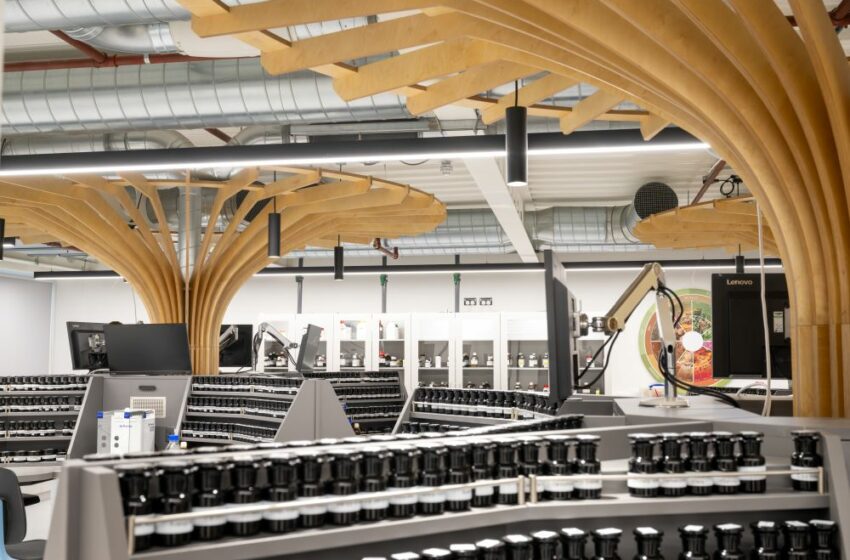
BAT’S new U.K. Innovation Center demonstrates the company’s commitment to become a predominantly smokeless business.
By George Gay
Is BAT edging into the field of transhumanism, specifically democratic transhumanism? This thought struck me when, during an introductory presentation ahead of a tour of BAT’s new U.K. Innovation Center in Southampton, the company’s director of research and science, James Murphy, described the range of BAT products now on offer, a seven-category range that transcends nicotine to include well-being and stimulation products.
Using science, technology and innovation to take human beings to the next level is, of course, a rough definition of transhumanism, and doing so with a product that can be afforded by most people would put this project into the realm of democratic transhumanism. Certainly, such speculation is not at odds with BAT’s stated aim of creating “A Better Tomorrow.”
On a more practical level, what to me was most significant about the Innovation Center and the research and development site within which it sits was the ambition on display. Hundreds of specialists are working there on prototype smokeless tobacco and nicotine products, on scientific research to determine the relative risk of using such products compared to smoking cigarettes and on building capabilities beyond nicotine. This is tobacco harm reduction (THR) plus—writ large.
Doing Good and Making Money
Of course, a lot of people opposed to or unconvinced of the benefits of THR claim that the major tobacco companies are only in business to turn a handsome profit and don’t care about the harm they cause nor about reducing it. And it is true that these companies are hugely profitable. Murphy mentioned that BAT had reported revenues of just over £27 billion ($33.93 billion) and profits of about £12.5 billion in its latest full-year results. But what seems to get lost in this argument is that it is possible to do good while making a handsome profit: one only need look at pharmaceutical companies to realize this is true. Indeed, perhaps it is necessary to make such profits because the investments needed to reinvent an industry, which is what is happening in respect of the tobacco industry, are not inconsiderable.
That BAT is reinventing its business can be seen from the fact that of the just-over £27 billion in revenue the company earned, £3.5 billion came from its new category business. Again, the cynics will point out that the new category business made up only a relatively small part of the overall business. And again, this is true, but that reading of the situation needs some grounding. BAT launched its first new category product only in 2013, so while it has been manufacturing traditional tobacco products and people have been consuming those products for more than 100 years, it has been offering new category products for just over 10 years. Additionally, while combustible tobacco products are on sale universally, because regulatory climates vary around the world, the sale of reduced-risk, noncombustible products is allowed only on about 55 percent to 60 percent of markets, something that Murphy chalked up as one of the challenges BAT faced. How, he wondered aloud, could more regulators be encouraged to embrace THR?
Unfortunately, if the February Conference of the Parties (COP10) to the World Health Organization Framework Convention on Tobacco Control (FCTC) (see “Doubling Down on Failure,” page 12) is anything to go by, the answer to Murphy’s question must be, “with difficulty.” Apparently, the Global Alliance on Tobacco Control, previously known as the Framework Convention Alliance, used COP10 to hand its “Dirty Ashtray” award to the Philippines for having had the temerity to promote THR.
And while the intellectual debate around THR bumps along the bottom in this way, there seems little hope of quickly expanding the number of markets where regulated THR products are made available. Not surprisingly, the WHO holds sway in many countries, especially those that find it difficult to fund independent health research.
The investment in the Southampton facility follows the opening of BAT’s Innovation Centers in Italy and China.
The Promise of New Products
This is all very sad because those who call the FCTC shots refuse to engage with the tobacco industry even though the industry has much to say that is informed and interesting to anybody concerned with reducing the harm caused by cigarette smoking. And one industry voice worth listening to is that of Elaine Round, a geneticist who is head of the global life sciences team at Southampton, where she has been for two years on an international assignment for U.S.-based R.J. Reynolds, which BAT bought in 2017.
Alongside Murphy, Round took part in the introductory presentation to a group of journalists, and it soon became clear that while she was involved in the THR quest in a scientific capacity, she also had skin in the game. Before describing some of the results of the emissions and toxicology tests that BAT carries out on its three main reduced-risk products, Round mentioned that she had joined Reynolds in 2008 when she saw a job description that indicated the company was making efforts around harm reduction. At that time, she said, people in her family smoked, and she wanted to make sure they had options to use reduced-risk products if they were unwilling to quit.
That timeline, which suggests that the tobacco industry has been concerned with THR for longer than most people realize, probably needs some explanation. Reynolds was in the vanguard of the quest for reduced-risk products and, as far as I am aware, was the first company to produce a heated-tobacco product (HTP). That product, which was different from the HTPs available today and which, for various reasons, was commercially unsuccessful, nevertheless provided a spark that was later to be reignited.
The three main reduced-risk products described by Round comprised the vaping device Vuse, the HTP Glo and the oral nicotine pouch Velo, for which BAT scientists have published respectively 81, 85 and 25 peer-reviewed studies. Vuse delivered toxicant levels 99 percent lower than those of a combustible cigarette, Round said, while Glo delivered toxicant levels 90 percent to 95 percent lower, and Velo delivered toxicant levels 99 percent lower compared with those of cigarette smoke.
Velo nicotine pouches must comprise one of the most interesting reduced-risk products to emerge in recent years because they produce toxicant levels down even on those of snus, an oral product that has been credited with helping to reduce the smoking rate in Sweden to around 5 percent and having thereby sent lung cancer rates in that country crashing. Indeed, nicotine pouches sit comfortably alongside nicotine-replacement therapy products on the continuum of risk and are perhaps the most environmentally friendly of all the reduced-risk products being used to assist smokers to move away from cigarettes. It is not surprising, therefore, that BAT has demonstrated its confidence in this product by including in its Innovation Center a nicotine pouch pilot plant that allows researchers to go from concept to trial product in an hour.

Supporting the Mission
Officially opened on March 7 in the presence of BAT’s entire management board, the Innovation Center is housed within BAT’s Southampton research and development facility, which has been in operation since 1956 on a site occupied by the company for more than 100 years. In a press note, BAT said the £30 million investment in the Innovation Center would support its mission to become a predominantly smokeless business in which 50 percent of its revenue was derived from noncombustibles by 2035.
The group of journalists, of which I was one, was given, on March 8, a tour of the Innovation Center, entering by way of a vast atrium that put me in mind of going to school in a finger-concealing blazer with the words of my mother ringing in my ears, “you’ll soon grow into it.” Clearly, bigger and better things will be happening there in the years to come. Some of the Innovation Center was off limits because of commercial sensitivities, and we passed various spaces that were yet to be occupied. But we were taken into a large flavors laboratory, which is likely to be at the forefront of the battle to keep reduced-risk products appealing to adult consumers while complying with the seemingly inevitable restrictions imposed by regulators fearful of these products being used by those underaged. Overlooking the working, clean-space, nicotine-pouch pilot plant from a room above and adjacent to it was a highlight of the tour, but I was amazed, too, at the large number of specialists working at computers on new product design, until it was pointed out to me that products must be customized to a certain extent to meet the regulatory requirements and consumer preferences of many different markets.
The Innovation Center provides nine specially designed technical spaces to aid the development of BAT’s portfolio of new category products. “These spaces are dedicated to research for modern oral nicotine pouches, for liquids and flavor for vapor products, for heated products and for well-being and stimulation beyond nicotine,” the press note said. “The investment will also support work on packaging, engineering, innovation development and system integration ….
“The new facilities will bring together cross-functional and key R&D teams—with 400 highly specialized scientists and engineers, drawn from a range of fields, including biotechnology and clinical trials. These teams will accelerate the development of the next generation of BAT’s new category products and provide the robust evidence necessary to encourage adult smokers to switch to less risky alternatives, backed by science.”

A Positive Path
Meanwhile, BAT said it had more than 1,600 specialists spread across the U.K., the U.S., Brazil, Indonesia, Malaysia and China. “The £30 million investment in the Southampton facility follows the opening of BAT’s Innovation Centers in Trieste, Italy, in 2021 and in Shenzhen, China, in 2022, and an investment of £300 million a year in R&D to develop new category products and establish substantiation of their reduced-risk potential,” the company said.
This summary of the totality of BAT’s investment in R&D is significant because it gives an indication of the capability uplift the company has had to bring about within its ranks during a relatively short time and therefore its commitment to THR and, more latterly, well-being products. In 1956, and for a long time afterward, the R&D carried out at Southampton would have involved mostly scientists working with tobacco while in recent years, it has had to venture into fields formerly far beyond its comfort zone, so it has had to recruit, for instance, software engineers, formulation chemists and flavorists.
I started this piece by speculating about whether BAT was venturing into transhumanism. That was a bit of a stretch, but it is worth noting that the company, at Southampton and its other Innovation Centers, is carrying on in a specialist field the humanist project that stretches back to the Enlightenment and the use of scientific methods to better understand the world and the place of humans within it. The cynics will point out that the Enlightenment journey has not always wound up in good places, and, again, this is true, but I cannot see how anybody could argue that the general direction of travel has not been hugely positive. Science-led THR, properly applied, follows in that direction.












